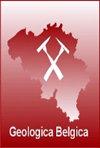A review of the lower and middle Miocene of northern Belgium
IF 0.7
4区 地球科学
Q2 GEOLOGY
引用次数: 13
Abstract
1. Introduction The North Sea was a semi-enclosed basin during the Neogene. The marine connection between the southern North Sea Basin and the Channel was prevented by the Weald-Artois ridge, while in the north an open marine connection with the Norwegian-Greenland Sea existed (Ziegler, 1990; Rasmussen et al., 2008; Rasmussen et al., 2010). Tectonic uplift of northern Belgium during late Oligocene time pushed the southern coastline of the North Sea northwards, and late Oligocene sedimentation in Belgium was limited to a thin cover of glauconitic sand in northern Belgium; it is only well developed in the subsiding Roer Valley Graben (RVG) in the very northeast (Dusar et al., 2020, this volume). At the beginning of the Miocene, during the global sea-level rise after the Mi1 glacial maximum (Miller et al., 1991), sea levels rose and northern Belgium was invaded by a marine transgression from a northern to northwestern direction (Louwye, 2005). Furthermore, Munsterman & Deckers (2020, this volume) recorded in two wells in the northeastern part of the Campine latest Oligocene – earliest Miocene (Aquitanian – early Burdigalian) deposits and proposed a transgressive phase from the Roer Valley Graben towards the Campine area. The marine and continental lower and middle Miocene deposits are restricted to northern Belgium and crop out in the vicinity of the city of Antwerp (Fig. 1). In the Campine area, east of Antwerp, lower and middle Miocene sediments are present in the subsurface比利时北部中新世中下段的评述
1. 新近纪北海是一个半封闭的盆地。北海盆地南部和英吉利海峡之间的海洋连接被Weald-Artois海脊阻断,而在北部则与挪威-格陵兰海存在开放的海洋连接(Ziegler, 1990;Rasmussen et al., 2008;Rasmussen et al., 2010)。晚渐新世比利时北部的构造隆升将北海南部海岸线向北推进,晚渐新世比利时北部沉积仅限于海绿石砂薄盖层;它只在最东北部的下沉的Roer Valley地堑(RVG)中发育良好(Dusar et al., 2020,本卷)。中新世之初,在Mi1冰期极大期后全球海平面上升期间(Miller et al., 1991),海平面上升,比利时北部受到从北向西北方向的海侵(Louwye, 2005)。此外,Munsterman & Deckers(2020,本卷)在Campine晚渐新世-早中新世(Aquitanian - burdigian早期)沉积的东北部的两口井中进行了记录,并提出了从Roer Valley地堑向Campine地区的海侵阶段。海相和陆相中新世下和中沉积物局限于比利时北部,并在安特卫普市附近出现(图1)。在安特卫普以东的Campine地区,下中新世和中中新世沉积物存在于地下
本文章由计算机程序翻译,如有差异,请以英文原文为准。
求助全文
约1分钟内获得全文
求助全文
来源期刊

Geologica Belgica
地学-地质学
CiteScore
4.70
自引率
27.80%
发文量
8
审稿时长
>12 weeks
期刊介绍:
Geologica Belgica is a Belgian journal that welcomes papers concerning all aspects of the earth sciences, with a particular emphasis on the regional geology of Belgium, North West Europe and central Africa. Papers not dedicated to the geology of Belgium, North West Europe and central Africa are only accepted when one of the authors is linked to a Belgian University or Institution. Thematic issues are highly appreciated. In this case, guest editors take in charge the selection of the manuscripts and the subject of the papers can be enlarged. The journal is in open access.
Submitted manuscripts should be concise, presenting material not previously published. The journal also encourages the publication of papers from Belgian junior authors. Short letters are accepted. Papers written in English are preferred. Each mansucript will be reviewed by at least two reviewers.
 求助内容:
求助内容: 应助结果提醒方式:
应助结果提醒方式:


